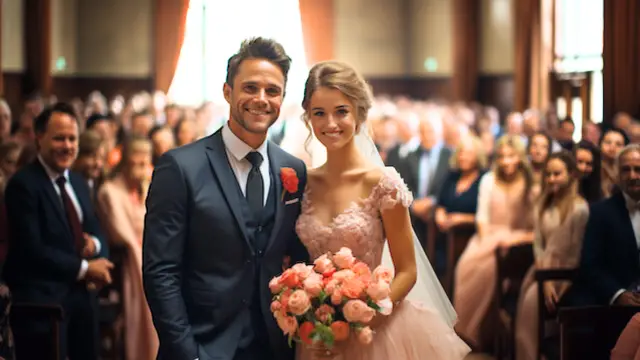Mastering the Wedding Ceremony Order of Events: The Ultimate Outline
Whether you’re planning a sun-kissed beachfront wedding in Hilton Head, SC, or a time-honored ceremony in the grandeur of St. Patrick’s Cathedral in NYC, mastering the Wedding Ceremony Order of Events is essential.
Planning your special day often comes with a mixture of excitement and nerves as you approach the heartfelt moment of saying “I do” amidst loved ones.
At the same time, it is a very happy moment in your life when you reflect on how far your relationship has come.
Adapting the customary framework of wedding ceremonies allows for a personalized touch to an otherwise structured progression. Your ceremony is your own to mold, reflecting both individuality and respect for tradition.
As you plan, remembering the magnitude and joy of this major life step can bring peace and clarity, guiding you through the final stages of preparation and rehearsal right up until the final, memorable moments before you walk down the aisle.
Traditional Wedding Ceremony Order
Couples seeking a classic yet flexible wedding format that’s easy to personalize, suitable for interfaith or non-denominational marriages, appealing to all guests, straightforward to plan, and blends formal with intimate elements will find the traditional wedding ceremony order ideal.
Here is a breakdown of the traditional wedding ceremony order:
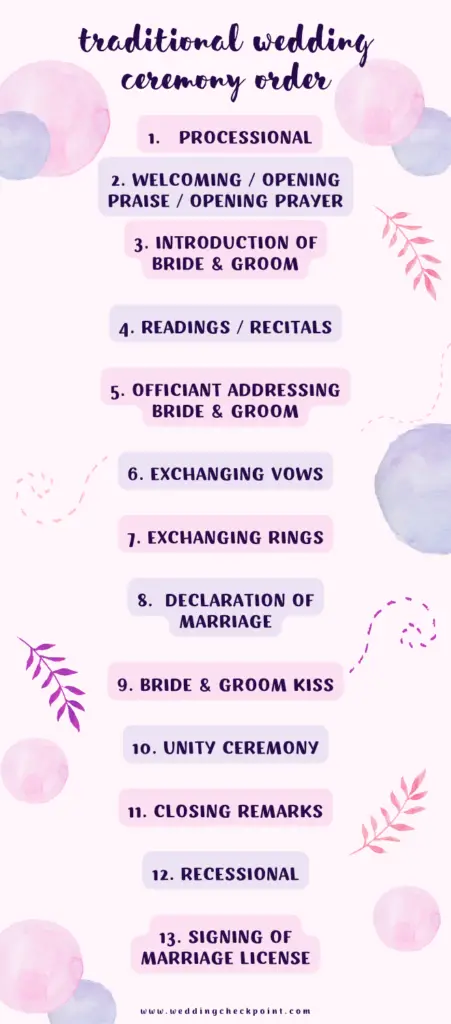
1. The Grand Processional: Starting Your Ceremony with Elegance
The beginning of your wedding ceremony is headed by the processional. In this part, the wedding party is lined up and walks down the aisle in a pre-determined sequence, coupled with synchronized music and timing.
In a traditional sequence, the arrival begins with the officiant, followed by the groom and best man.
The groomsmen may walk solo or accompanied by bridesmaids.
Next, the maid of honor makes her entrance, possibly followed by flower girls and the ring bearer.
The bride then progresses down the aisle, typically escorted by her father or chosen person.
2. Welcoming Words and Blessings: Setting the Tone for Your Wedding
Following the procession, the officiant welcomes everyone and may offer opening remarks or a prayer to bless the event, expressing gratitude for the presence of guests and acknowledging the significance of the occasion.
3. Introduction of Bride & Groom
The officiant introduces you, often sharing anecdotes or the significance of marriage, potentially touching upon how you met or your journey together thus far.
4. Heartfelt Readings and Recitals: Personalizing Your Ceremony
Readers and performers, introduced by the officiant, share significant texts or renditions from literature, poetry, or music, adding emotional depth to the ceremony.
5. Wisdom from the Officiant: Deepening the Meaning of Your Union
The officiant will now refocus on the bride & groom and explain the duties and responsibilities of a married couple and the sacredness of their commitment to each other.
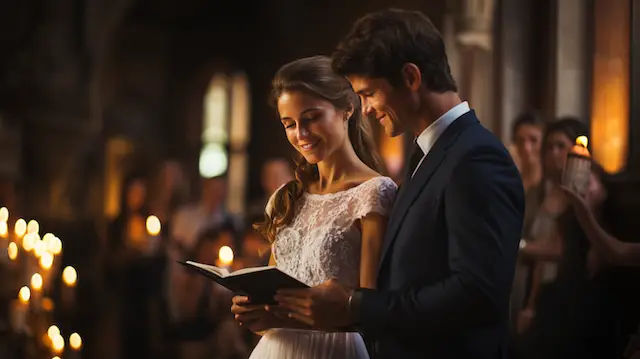
6. Vow Exchange: The Heart of Your Wedding Ceremony
A few minutes are given to each bride and groom to express their love and commitment to one another through their marriage vows. You will anchor and deepen your personal promises guiding you throughout your journey that is about to begin.
7. Ring Exchange: Symbolizing Your Eternal Bond
The officiant is now directing you to the next part of the wedding ceremony, in which you repeat binding words while placing the rings on each other’s fingers. This visually symbolizes the couple’s permanent tie and loyalty to each other.
8. Declaring Your Commitment: The Pinnacle of Your Wedding Ceremony
The marriage declaration goes hand in hand with the exchanging of your rings. This is the bride & groom’s declaration of intent when you say the literally “yes I do” after the officiant is asking you in front of witnesses, “Do you … take … to be your lawfully wedded… ” or “I, …, take you, …, to be my lawfully wedded…” ending with officially declaring you as husband and wife.
9. Sealing Your Love: The First Kiss as Newlyweds
Your first kiss as husband & wife after tying the knot. Following such a pivotal moment, you will be able to relax now that the formal proceedings have been completed.
10. Unity Ceremony: Visually Celebrating Your Union
If you are planning to add a unity ceremony, this is the best time to weave it into the fabric of the wedding ceremony. It is another custom to symbolize your connection by, i.e., lighting a candle together or using another symbol to visualize your union (i.e., handfasting with a ribbon or pouring unity sand together from different vessels).
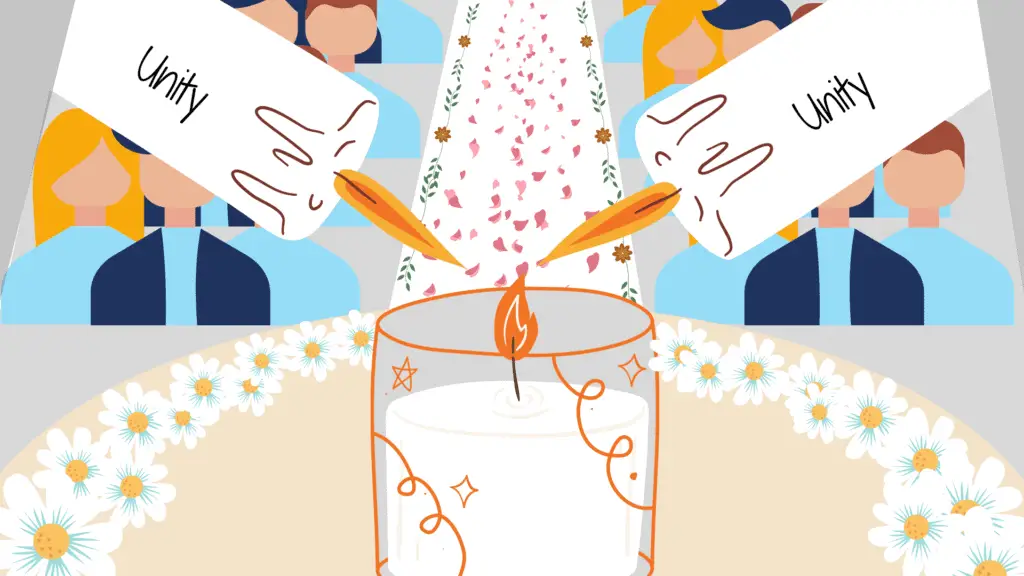
11. Final Blessings: Concluding Your Memorable Ceremony
In closing the wedding ceremony, the officiant invites the guests to the reception, followed immediately by music for the recessional.
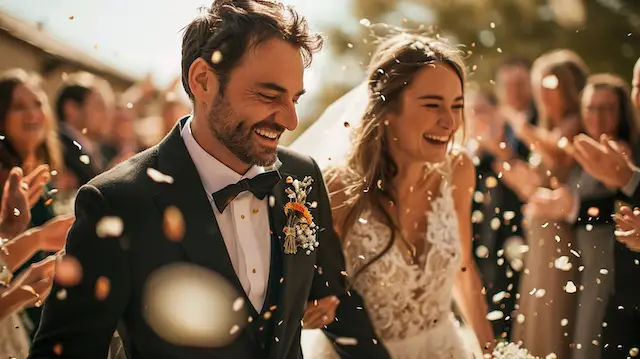
12. The Joyful Recessional: Ending on a High Note
At the conclusion of the wedding ceremony, the couple makes their grand exit. Following them should be the bridal party in reverse order of how they entered.
The Best Man & Maid of Honor exit first, followed by the Groomsmen & Bridesmaids, Parents, Flower Girl & Ringbearer, and Grandparents. Then the guests follow, usually starting with the closest row to the front of the room.

13. Legalizing Your Love: The Marriage License Signing
Finally, the wedding ceremony is not complete without the signing of the marriage license by you, the officiant, and witnesses, ensuring your marriage is recognized by law.
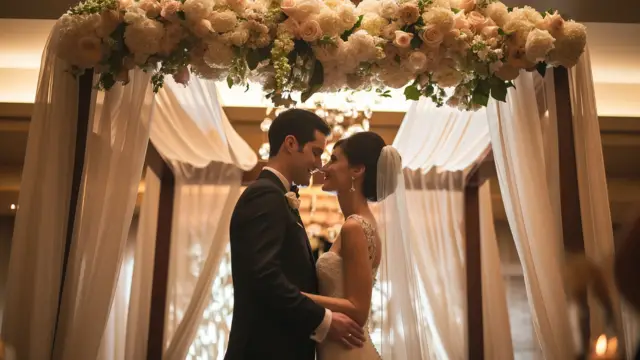
Jewish Wedding Ceremony Order
A Jewish wedding is a tapestry of various rituals and traditions interweaving to create a ceremony rich in meaning and heritage.
Key elements of the ceremony include the signing of the Ketubah, or marriage contract, which outlines the responsibilities of each partner. The couple exchanges rings under the chuppah, or wedding canopy, and the Sheva Brachot, Seven Blessings, is recited. These traditions are observed across many Jewish communities, with regional and cultural variations adding distinctiveness to each wedding.
1. Pre-Wedding Rituals
Kabbalat Panim, or “receiving of the faces,” is when you gather for the pre-wedding reception. During this time, the bride and groom welcome guests separately.
Tish: For the groom, this reception is also known as the Tish, where he sits at a table with the men, signing the tenaim, a formal document outlining the marriage conditions.
Bedeken: Following the Tish, you’ll witness the Bedeken, the veiling ceremony. It is one of the most emotional moments, where the groom approaches the bride and places the veil over her face.
2. Ceremony Structure
Your understanding of the Jewish wedding ceremony order is essential for grasping the significance of each tradition. Distinct parts, like the procession and the ceremony under the chuppah, are deeply rooted in Jewish culture, signifying the binding commitments of marriage.
3. Procession
It typically begins with the grandparents, followed by the groom with his parents. They proceed towards the chuppah, a marriage canopy symbolizing the couple’s future home. After the other wedding party members have taken their places, the bride then enters, escorted by her parents, signifying the merging of families.
4. Ceremony Under the Huppah
Once under the huppah, the ceremony begins with erusin, or kiddushin, the betrothal phase, which includes the blessing over wine and the giving and acceptance of a ring. At the conclusion of the ceremony, the sheva brachot and seven blessings sheva brachot are recited, and the groom breaks a glass with his foot, a powerful symbol marking the permanence of their union.
5. Circling and Kiddushin
During Kiddushin, the initial part of the ceremony, you will observe a powerful act of circling, where traditionally, the bride circles the groom seven times, representing the creation of a new familial world. This is the betrothal ceremony, where wine is blessed and consumed, signifying joy and celebration. The giving of the ring then follows, which finalizes the betrothal. It must be given by the groom to the bride and represents an object of value as a physical symbol of commitment.
6. Reading of the Ketubah
The ketubah, or marriage contract, is read aloud under the chuppah, the wedding canopy. This important document outlines the husband’s responsibilities to his wife and is signed by two witnesses. The text is often beautifully calligraphed and serves as a binding ritual that focuses on the rights and obligations of the bride and groom in their Jewish marriage.
7. The Nuptial Blessings
Following the reading of the ketubah, a series of nuptial blessings are recited over a second cup of wine. These blessings praise God for creating humans, bringing joy to the bride and groom, and for the sacred institution of marriage within the Jewish faith.
8. Sheva Berakhot and Concluding Rites
The ceremony climaxes with the recitation of the Sheva Berakhot, or seven blessings, which are recited over a third cup of wine.
9. Breaking of the Glass
To culminate the ceremony, the breaking of the glass is a powerful moment. As the groom crushes a glass underfoot, guests shout, “Mazel Tov!” symbolizing both the destruction of the Temple in Jerusalem and the irrevocable change in the lives of the newlyweds. This poignant act serves as a reminder that the recognition of life’s fragility must always temper joy.
10. The Recessional
After the cheerful “Mazel Tov!” shout, the recessional starts. The order is simply a reverse of the entrance, leading with the joyful newlyweds, followed by their parents and grandparents, symbolizing joy and heritage. Flower girls or ring bearers, the wedding party, and the best man, maid, or matron of honor come next. Finally, the rabbi and/or cantor concludes the recessional, signifying the ceremony’s end and the start of the couple’s married life.
11. Yichud
Immediately following the ceremony, you partake in yichud, a period of seclusion where you and your spouse retreat to a private room. This tradition symbolizes your new status as a married couple. It’s a chance to reflect on your commitment and share a few romantic moments together before joining the celebrations.
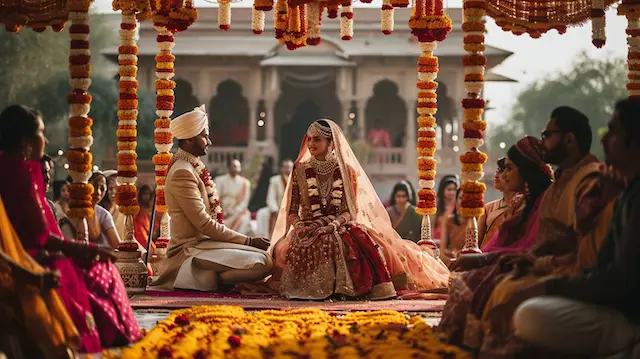
Hindu Wedding Ceremony Order
The ceremony itself unfolds in a detailed and symbolic order, giving great importance to various customs that have been passed down through generations. Central to the ceremony is the holy fire or Agni, symbolizing purity and the witness to the vows exchanged. Every ritual performed around the fire is designed to unite the couple, not just in matrimony but in spiritual partnership, reinforcing the depth and sanctity of the Hindu matrimonial ethos.
Wedding Day Rituals
1. Baraat: Groom’s Arrival
The Baraat marks the groom’s triumphant procession to the wedding venue, usually on a horse or elephant, accompanied by music and dance. Your family and friends celebrate with you as you make your way to the mandap, signifying the start of the wedding ceremonies.
2. Milni
Milni is the meeting of both families, where they exchange garlands and gifts. It signifies the unification of the two families and is a gesture of acceptance and respect.
3. The Bride’s Entrance
In a traditional Hindu wedding, the bride is often accompanied down the aisle by her brothers or male relatives, symbolizing their support and blessings as she embarks on her new journey. In some traditions, the bride may be escorted by her maternal uncle.
Additionally, in some ceremonies, the bride is carried in a doli (palanquin) or on a platform, reflecting the grandeur and sanctity of the occasion.
4. Kanyadaan: Giving Away the Bride
Kanyadaan is a poignant moment where the bride’s father gives her away to the groom, entrusting him with his daughter’s care. In Hindu customs, the groom cannot formally accept the bride until she has been formally offered to him.
5. Varmala: Exchange of Garlands
During Varmala or Jai Mala, the groom and bride exchange garlands made of flowers, symbolizing your acceptance of one another and the beginning of your journey together.
6. Vivah Homa (Sacred Fire Ritual)
The Vivah Homa involves invoking Agni, the god of fire, to witness your commitment. A fire is lit within the mandap, and you recite mantras as offerings are made to the fire, symbolizing the start of your duties as a husband.
7. Pani Grahan
In Pani Grahan, you take your bride’s hand, signifying your union and your promise to care for her and respect her wishes.
8. Pratigna-Karan
During Pratigna-Karan, you and your bride exchange vows around the fire with promises of love, fidelity, and lifelong commitment to each other.
9. Shilarohan and Mangal Pheras
Shilarohan involves your bride stepping on a stone by the mandap, symbolizing her strength and resolve to overcome obstacles. Following this, Mangal Pheras are performed where you circle the fire, signifying aspects of life you pledge to pursue together.
10. Saptapadi: Seven Steps
You then take the Saptapadi, or seven steps, together around the holy fire. Each step represents a vow, leading to a legally binding union, and encompasses virtues such as trust, respect, and commitment.
The bride’s sari and the groom’s shawl are often tied together during the Saptapadi, symbolizing their union. This knot represents an unbreakable bond and the joining of their souls.
The number seven holds significant spiritual and religious importance in Hinduism. It is considered auspicious and represents numerous cycles in Hindu cosmology, like the seven sages (Saptarishi) and the idea of seven lives or reincarnations.
11. Talambralu
During the ritual, the bride and groom take turns to shower each other with handfuls of the Talambralu mixture. It begins with the couple taking turns to gently shower the rice over each other’s heads, which gradually turns into a playful exchange. Talambralu” refers to a mixture of rice grains coated with turmeric powder and sometimes mixed with pearls, saffron, and other fragrant items. ‘Talam’ means plate, and ‘Brallu’ means rice, referring to the plates of this sacred rice mixture used in the ritual.
12. Ashirwad (Blessings)
Finally, the ceremony concludes with Ashirwad, where the priest and elders bestow blessings upon you as a couple for a prosperous, healthy, and happy life.
It’s customary in many parts of India for the couple to touch the feet of their elders during the Ashirwad as a sign of respect and to receive their blessings.
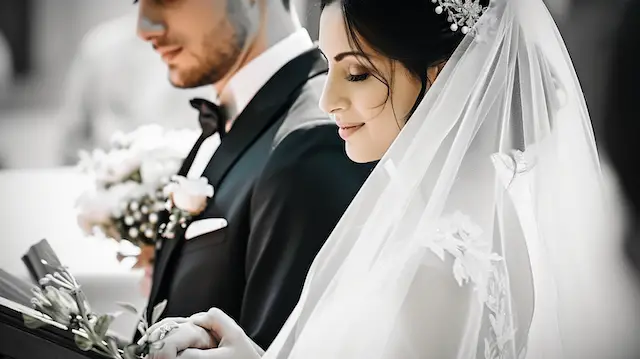
Catholic Wedding Ceremony Order
When you attend a Catholic wedding, you’re participating in a ceremony rich with tradition, symbolizing the sacrament of matrimony. Celebrated within a church, the setting itself is an embodiment of the couple’s faith and commitment in the presence of God.
- Solemnity and Dignity: The atmosphere in a Catholic church during a wedding is one of solemnity and dignity, reflecting the significance of the vows being made.
- Sacrament: In the Catholic faith, marriage is more than a legal contract; it’s a sacrament. This sacred ritual signifies a lifelong commitment and the grace to honor that commitment.
- Vows: Your vows are the verbalized expression of your promise to each other. They aren’t merely words but vows taken before God, binding and recognized in the Catholic church.
- Community and Witness: As part of the ceremony, you will be surrounded by friends, family, and the faith community, all there to witness and support your union.
Keep in mind that a Catholic wedding ceremony can vary slightly, depending on whether you choose to have a Nuptial Mass. If both partners are Catholic, it is customary to have a Mass, which includes the Liturgy of the Eucharist.
1. Entrance Procession
Typically, the order of the procession is crucial, starting with the groom and the best man waiting at the altar. Following them, pairs of bridesmaids and groomsmen walk down the aisle, succeeded by the ring bearer and flower girl. Lastly, the bride will make your grand entrance, often escorted by the father of the bride.
2. First Reading – Liturgy of the Word
Traditionally, the First Reading is taken from the Old Testament and read by a lector, a person you choose because of their special role in your life and ability to convey the scriptures to your wedding congregation. This reading often focuses on love, fidelity, and the covenant of marriage.
3. Responsorial Psalm
Following the First Reading, the Responsorial Psalm meditatively reflects on the words you’ve just heard. Often sung by a cantor, the psalm allows you, the couple, and the congregation to respond to God’s Word in song, reinforcing the message of commitment and unity as described in the psalm.
4. Second Reading
For the Second Reading, selections from the New Testament echo the themes of love and commitment central to your marriage are chosen. This reading, also delivered by a lector, offers New Testament perspectives on the blessings and responsibilities of married life.
5. Gospel Acclamation
Before the Gospel reading, the congregation joins in the Gospel Acclamation, typically with the words “Alleluia” or “Praise to you, Lord Jesus Christ.” This exclamation is a way to greet the Gospel and a sign of recognition for the importance and sanctity of the Gospel of the Lord that is about to be proclaimed.
6. Gospel Reading
The Gospel Reading is an excerpt from one of the four Gospels read by the priest or deacon. This reading underscores the teachings of Christ, reflecting on the principles that should guide you in your married life and offering you an example of divine love and faithfulness.
7. Homily
Following the readings, the Homily provides a moment for the priest or deacon to offer reflections on the readings and tie their messages to the sacrament of marriage. This personal and tailored address speaks to your unique journey as a couple, emphasizing how the scripture readings can illuminate your path forward together.
8. Exchange of Vows – Rite of Marriage
You and your partner come together to express your mutual consent. Through the Exchange of Vows, you verbally commit to a lifetime of love and fidelity. Typically, you will take turns, beginning with a statement of intent and proceeding to the vows. You’ll say: “I, (Name), take you, (Name), to be my husband/wife.” This solemn exchange seals your intent to enter into a covenant of marriage.
9. Blessing of the Rings
After declaring your vows, the Blessing of the Rings takes place. The presider will often bless your wedding rings with holy water to symbolize your unbreakable bond. You will then place the rings on each other’s fingers, often with the words, “Name, take this ring as a sign of my love and fidelity.”
10. Nuptial Blessing
The Nuptial Blessing is a prayer invoking God’s grace upon the newly married couple. The presider offers This special blessing, who may use holy water as he calls upon God to make your bond fruitful and grant you both the strength to uphold your marriage vows.
11. Prayers and Intercessions
Concluding the ceremony, the Prayers and Intercessions, or the Universal Prayer, capture the communal support of your marriage. It includes a series of petitions for the well-being of the couple, the church, and the world—often referred to as the Prayer of the Faithful or General Intercessions. This portion concludes with reciting the Lord’s Prayer, followed by the Sign of Peace,.’ where you may exchange a kiss.
12. Liturgy of the Eucharist
During the Liturgy of the Eucharist, the bread and wine are presented, consecrated, and shared among the faithful. This central part of the Mass symbolizes the Last Supper and represents the presence of Jesus as the Eucharist is received.
13. Presentation of the Bread and Wine
You’ll observe members of the congregation bringing forth the gifts of bread and wine, which are placed on the altar. Sometimes, these may also include other offerings for the church or poor. A prayer is then said by the priest to bless these gifts.
14. Eucharistic Prayer
This is the most solemn part of the Mass, where the priest recites the Eucharistic Prayer. It is a thanksgiving and consecration prayer that includes the calling down of the Holy Spirit (Epiclesis) and the recitation of the words of Jesus at the Last Supper, known as the Institution Narrative.
15. The Lord’s Prayer
Following the Eucharistic Prayer, you’ll join the congregation in reciting The Lord’s Prayer, also known as the ‘Our Father.’ This universally known prayer asks for daily sustenance, forgiveness, and deliverance from evil.
16. Sign of Peace
Subsequently, a Sign of Peace is exchanged among the congregation. You’ll typically shake hands or offer another gesture of peace to those around you, symbolizing unity and reconciliation before Communion is taken.
17. Holy Communion
Finally, the consecrated bread and wine – now believed to be the Body and Blood of Jesus – are distributed to Catholics in the state of grace. You receive Holy Communion reverently, reflecting on the sacrifice of Jesus and your communion with him and the Church.
In participating in the Liturgy of the Eucharist, you are reaffirming your faith and uniting yourself with the Catholic community in worship and remembrance of Jesus’s sacrifice.
18. Final Blessing
The final blessing is a pivotal moment where you receive a prayer and a heartfelt appeal for divine grace. Typically, this blessing includes the Sign of the Cross, symbolizing the sanctification of your union. It emphasizes themes such as acceptance, freedom of choice, and the importance of upbringing children within the faith should you choose to have them. Integral to this blessing are the wishes for support and strength; as the ministers and the officiant formally bid you and your guests farewell, the choir may lead the congregation in prayer, often culminating with a request for a peaceful and joyful life.
19. Dismissal
Following the final blessing comes the dismissal, where the officiant formally bids you and your guests farewell. This is not merely a conclusion; it’s a sending forth with a mission to live out the vows you’ve taken. In essence, the dismissal is both an acknowledgment of the ceremony’s end and an invitation to commence the everyday work of marriage. The officiant may say, “Go in peace, glorifying the Lord by your life,” inviting you to integrate the grace you’ve received into all facets of your life together.
20. Recessional
The recessional is your first walk as a married couple, signifying the closing of your wedding ceremony. As celebratory music fills the air, you will make your exit, followed by the bridal party and your guests. The mood here is joyful and triumphant, underscored by the music, which often includes both religious hymns and uplifting gospel readings. The recessional is a visual representation of your transition from the church to the world, ready to live out the love and commitment you’ve just solemnized.
Frequently Asked Questions
What is the typical wedding ceremony order of events?
The typical wedding ceremony order of events includes the processional, opening words, readings, vows, exchange of rings, unity ceremony, pronouncement, and recessional.
What is the importance of having a wedding ceremony outline?
A wedding ceremony outline helps to ensure that all the important parts of a wedding ceremony are organized in a logical and meaningful way, providing a smooth and memorable experience for the couple and their guests.
What are the different types of wedding ceremony orders?
There are various types of wedding ceremony orders, such as the traditional ceremony order, Catholic ceremony, religious wedding, nondenominational wedding ceremony order, and more, each with its own specific order of events and customs.
How should the processional order be arranged in a wedding ceremony?
The processional order in a wedding ceremony is typically arranged with the wedding officiant, parents of the couple, wedding party, and finally, the couple in a specific order, symbolizing the beginning of the ceremony.
What is a unity candle and how is it incorporated into the wedding ceremony?
A unity candle is a symbol of the unity of the couple and their families. It is often incorporated into the wedding ceremony by the couple lighting a single candle together, representing the merging of their lives.
How can I plan the order of events for a religious wedding ceremony?
Planning the order of events for a religious wedding ceremony involves consulting with the officiant, understanding the religious traditions, and ensuring that the different elements of the ceremony, such as readings and prayers, are incorporated appropriately.
What is included in a typical wedding ceremony script?
A typical wedding ceremony script includes the opening words, readings, vows, exchange of rings, unity ceremony, pronouncement, and recessional, with specific wording and instructions for the officiant and the couple.
How can I create a wedding ceremony timeline?
To create a wedding ceremony timeline, you should consider the start time, the duration of the ceremony, and the sequence of events, ensuring that there is enough time for each portion of the ceremony and any additional customs or rituals.
How should I handle the planning of the order of the wedding ceremony?
You should handle the planning of the order of the wedding ceremony by considering the specific order of events that are meaningful to you and your partner and consulting with your officiant or wedding planner to ensure a smooth and well-organized ceremony.
What are the basic parts of a wedding ceremony?
The basic parts of a wedding ceremony include the processional, opening words, readings, vows, exchange of rings, unity ceremony, pronouncement, and recessional, forming the core elements of the ceremony.

